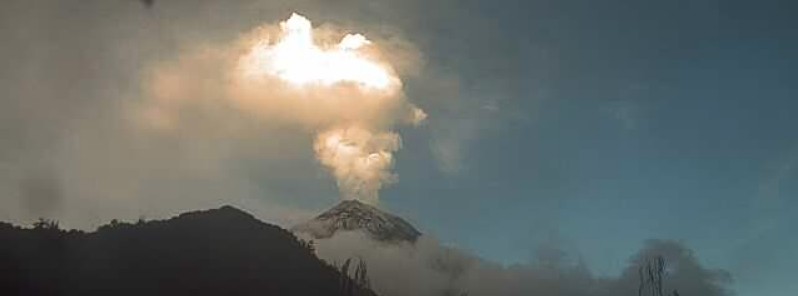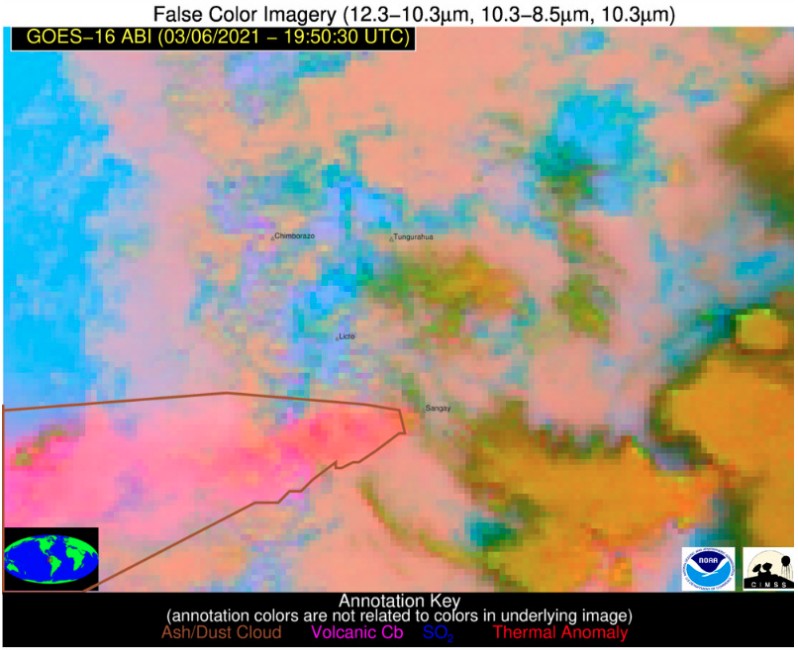Large eruption at Sangay volcano, ash to 12.2 km (40 000 feet) a.s.l., Ecuador

A large eruption started at Sangay volcano, Ecuador at around 04:00 UTC on March 6, 2021, producing a volcanic ash column up to 12.2 km (40 000 feet) above sea level, according to the Washington VAAC.
Strong ashfall was reported in Chimborazzo: Pallatanga, Chunichi, Guamote, Alausi, and Cumanda; moderate in Guayas: Alfredo Baquerizo Moreno; and mild in Milagro, San Jacinto de Yaguachi, El Triunfo; Los Rios: Babahoyo; Bolivar: Chillanes, San Miguel and Canar: Suscal.
According to the IG report, the cloud generated by the volcano was expected to reach the province of Santa Elena, causing a slight ashfall.
Authorities urged citizens to keep calm and take the appropriate precautions to protect their health.
Cae y cae y cae, sur de #Guayaquil pic.twitter.com/Nep6J49u59
— Dªⓥîd ®. Z. (@xxDAVICHOxx) March 6, 2021
Ceniza en las vías del Ecuador
Precaución al conducir pic.twitter.com/KXzhO0MENv— C.U.P.S. (#QuédateEnCasa ) (@Cupsfire_gye) March 6, 2021
Caída de #ceniza por Simón Bolívar – Jujan pic.twitter.com/NrMzgG0VIo
— C.U.P.S. (#QuédateEnCasa ) (@Cupsfire_gye) March 6, 2021
[COMUNICADO] De acuerdo a monitoreo realizado por @Riesgos_Ec, al momento se registra caída de ceniza entre fuerte, moderada y leve en las provincias de #Chimborazo #Guayas y #Bolívar. Tome precauciones pic.twitter.com/xH3OsZfJcB
— Riesgos Ecuador (@Riesgos_Ec) March 6, 2021
By 21:20 UTC on March 6, the leading edge of volcanic ash to 12.2 km (40 000 feet) above sea level was 296 km (184 miles) west of the summit while volcanic ash to 8.2 km (27 000 feet) a.s.l. extended 130 km (80 miles) WSW of the summit.


A total of 11 198 ha (27 670 acres) of crops have been destroyed in the provinces of Bolivar, Chimborazo, Guayas, and Los Ríos, affecting at least 24 557 farmers, after the major eruption of Sangay volcano on September 20, 2020, when volcanic ash also rose to 12.2 km (40 000 feet) a.s.l.
The National Risk Management Service has distributed 26 250 volcano kits to those most affected in the provinces of Bolivar, Chimborazo and Guayas. The Ministry of Agriculture has delivered forage for the cattle.
IGEPN volcanologists said that explosions and ash emissions on September 20 were much more energetic than any of those observed in the past couple of months. A large ash cloud was reported at 09:40 UTC, with the highest part of the cloud heading east, while the lower part headed west of the volcano.
On September 24, El Comercio reported 55 000 ha (135 900 acres) of banana crops were affected by ashfall, especially in the provinces of Guayas and Los Rios.
This area's production accounts for 25 to 30% of the fruit that is exported to the world on a weekly basis, equivalent to 1.5 million boxes. The worst affected areas were Naranjito and El Triunfo in Guayas, and Mata de Cacao in Los Rios.
Sangay is located in the Morona Santiago province, 41 km (25 miles) north-west of the city of Macas.
The current eruptive period began in May 2019. The activity is characterized by lava flows, pyroclastic density currents (pyroclastic flows), and gas and ash emissions.
Geological summary
The isolated Sangay volcano, located east of the Andean crest, is the southernmost of Ecuador's volcanoes and its most active. The steep-sided, glacier-covered, dominantly andesitic volcano grew within horseshoe-shaped calderas of two previous edifices, which were destroyed by collapse to the east, producing large debris avalanches that reached the Amazonian lowlands.
The modern edifice dates back to at least 14 000 years ago. It towers above the tropical jungle on the east side; on the other sides flat plains of ash have been sculpted by heavy rains into steep-walled canyons up to 600 m (1 979 feet) deep.
The earliest report of a historical eruption was in 1628. More or less continuous eruptions were reported from 1728 until 1916, and again from 1934 to the present.
The almost constant activity has caused frequent changes to the morphology of the summit crater complex. This volcano is located within the Sangay National Park, a UNESCO World Heritage property.
Featured image credit: IGEPN

Love this website, but disappointed by the tinfoil hats trolling the comments section. What makes them so eager to share their flat earth ignorance? Relative to volcanoes and climate change – consider the thousands of industrial cities of the world as large and constantly erupting volcanoes. If this goes on another 100 years, we may well see extinctions on par with deccan traps, etc. Denialism won’t protect you.
That’s what MSM would say. We are living interesting times. In a geological time frame, Earth has gone through many periods of increased volcanism. These volcanic periods resulted in; major plant and animal extinction events, the end of glacial eras and the dramatic alteration of Earth’s climate. All indications are that Earth is currently experiencing another period of strong volcanic activity which is acting to infuse CO2 into our atmosphere thereby demolishing the validity of the manmade global warming theory or better said scare.
+1
Grand Solar Minimum
Another volcano has erupted. Damn it, global warming is causing all these volcanoes to erupt at the same time, and if you do not believe me ask Joe Biden. Long live American democracy Hahahahahaha
Some so-called scientists ( I call them FAKE-Scientist) are even attempting to blame the ‘Earths poles shifting’ on man-made climate change instead of the other way around.